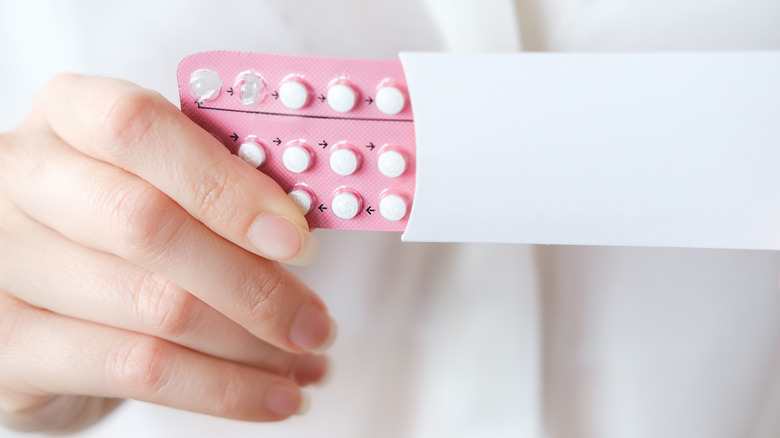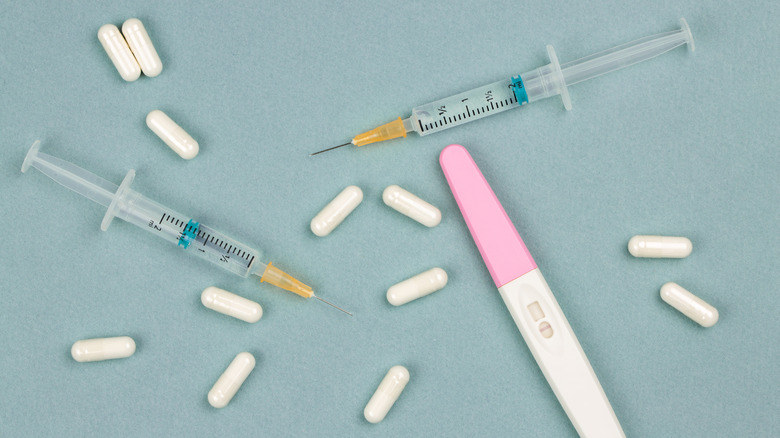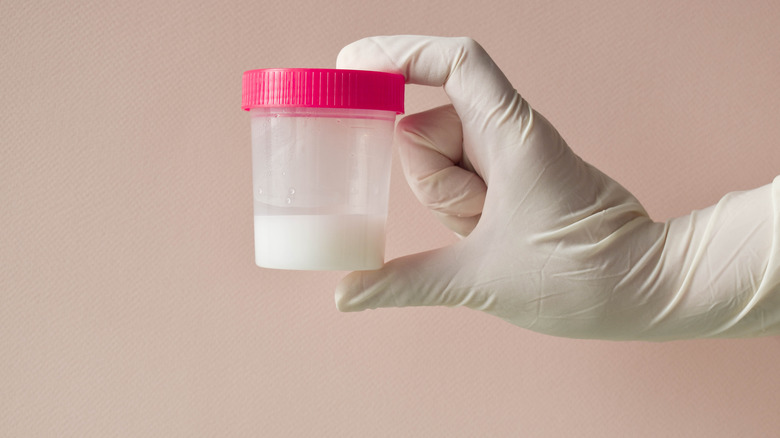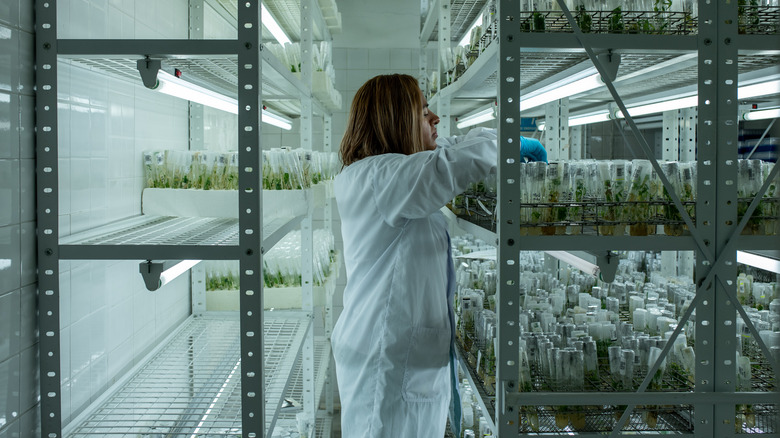Every Step Of The IVF Process Explained
If you are struggling with fertility issues, your doctor may have recommended trying in vitro fertilization or IVF. IVF is a very in-depth process that involves fertilizing the egg outside of the body before transferring the embryo into the uterus, where a standard pregnancy will hopefully follow thereafter. IVF can be a wonderful way to become pregnant if fertility is an issue — however, it's of utmost importance to understand the full process before you begin your journey with IVF.
If you are at the beginning of your IVF journey, you may be wondering what to expect. We spoke to a few fertility experts to provide a complete guide to each stage of the fertility process. From the first consultation to the egg removal to the embryo transfer to the procedure's aftermath, this breakdown of the IVF process will prepare you for what is to come so there won't be any surprises along the way.
What is IVF?
IVF stands for in vitro fertilization, which translates to mean fertilization outside of a living organism.
"Eggs are taken out of a woman's body, united with sperm and allowed to develop for three to five days before the resulting embryo is placed into a woman's uterus," Dr. Sue Ellen Carpenter, MD, a fertility specialist at Bloom Fertility tells The List. "In this case fertilization and early embryo development take place in an embryology lab or in the INVOcell device which is placed in a woman's vagina during incubation."
The process is usually recommended to women and couples who have been experiencing fertility issues and are looking for reproductive assistance. IVF has proven to be a relatively effective method of conception. In 2019, the Human Fertilization & Embryology Authority found that 32% of IVF embryo transfers led to a successful pregnancy — and according to studies, that number is increasing.
Deciding to go through the IVF process
Before you begin the IVF process, there are plenty of things to consider, from your finances to your overall health. According to Forbes, the entire IVF process usually costs between $15,000 and $30,000 in the US. Plus, for many people, multiple rounds of IVF are required before a successful pregnancy. In fact, six rounds of IVF have been shown to be the most successful (via RRC). However, some insurance plans, grants, and discount programs can help to reduce the cost of the procedure.
It's also important to consider the risks associated with IVF. As HFEA notes, risks include multiple births, fertility drug side effects like ovarian hyperstimulation syndrome, and birth defects. It's also possible that IVF might lead to higher blood pressure during pregnancy.
Finally, you should consider which type of IVF will suit you best: natural cycle IVF, mild stimulation IVF, or in vitro maturation. Be sure to speak to your doctor about which type is safest for you.
You may be put on birth control or your may start tracking ovulation
One of the first stages of IVF is often being given birth control by your doctor. While this may seem counterintuitive, it can help to regulate your periods and make ovulation more regular. It can also help to reduce the risk of ovarian cysts, which can sometimes be common in older patients, according to a 2012 study in the Balkan Medical Journal.
"In IVF we often surprise patients with the fact that we use a short course of birth control pills prior to the IVF cycle to interfere with the selection of a dominant follicle and allow a larger cohort of eggs to grow in unison," explains Carpenter. "In IVF, we have needed to recruit about eight eggs per live birth. A patient can be successful with fewer than that, but the ratio of 8:1 explains why we work to retrieve a larger cohort of eggs than you might anticipate."
You start taking a GnRH antagonist to stimulate the ovaries
Next, if you are going through the traditional protocol, your doctor may prescribe you a GnRH (gonadotropin-releasing hormone) antagonist to stimulate the ovaries in preparation for egg removal. The hormone stimulates the pituitary gland to release hormones that stimulate the ovaries. A 2006 study explained that introducing a GnRH antagonist "prevents a premature rise in serum luteinizing hormone (LH) levels in most women." GnRH is usually given through a series of injections but is sometimes taken orally.
While using a GnRH isn't necessary for the IVF process, many doctors may recommend it to increase your chances of a successful pregnancy. One 2021 study showed that a GnRH antagonist could help to improve the chances of live birth in women with endometriosis.
Some women experience side effects of the GnRH antagonist, such as headache, nausea, hot flashes, pelvic pain, fatigue, anxiety, and breathing issues.
On the day you get your period, your doctor will do some tests
The day of your period, your doctor will likely do a series of tests to ensure the body is ready for egg removal and embryo implantation later in the month. "our physician will get a blood test called AMH (anti-mullerian hormone) and an internal ultrasound of your ovaries as a way to estimate egg supply and plan your treatment," says Carpenter. "They may also check 'day 3' bloodwork for FSH, LH [two hormones], and estradiol to assess egg quality." You may undergo a diagnostic hysteroscopy or saline infusion sonogram, tests which help your doctor determine that the uterus is ready for receiving the embryo. "Finally, if not previously done, a radiology procedure called an HSG is done to assure there is no fluid accumulated in the fallopian tubes because such fluid interferes with embryo implantation in the uterus and can be treated prior to embryo transfer," she says.
In addition to your bloodwork and ultrasound, a semen analysis for your partner or donor will also be done. "Supplements may be recommended to optimize the quality of the sperm and of the eggs depending on this testing," says Carpenter.
Boost your egg production
If you haven't yet been given a GnRH, you might now receive drugs to stimulate your ovaries to produce more eggs. "The patient is given medication to stimulate follicle growth in order to get ovulation to produce multiple mature eggs," says Elizabeth King, a certified fertility expert, and birth doula, adding, 'I suggest getting a cute container to manage and track all your medications."
Adds Carpenter, "Oral fertility medications such as clomid or letrozole and injectable medications such as the pituitary hormones, FSH and LH (there are numerous brands) are used to encourage multiple eggs to develop. This process may require several office visits to document the growth of the eggs and plan the egg retrieval."
Your doctor will talk you through which medications you'll be taking and why — it might be slightly different for everyone. They'll also give you a comprehensive schedule to keep track of your medications and doctor's appointments in the lead-up to egg removal.
Egg removal
Egg removal takes place during the ovulation phase of your menstrual cycle. While egg removal may seem daunting, it's usually a completely painless process thanks to general anesthesia or sedation — sedation is the cheaper option and means you will be awake during the procedure. "When the eggs are ready for retrieval, your physician will use an internal ultrasound to guide needle aspiration of follicular fluid and the eggs," says Carpenter. 'The needle traverses your vaginal wall. Depending on the ovarian stimulation technique, it takes 10-30 minutes to retrieve the eggs." Once the eggs have been removed, your doctor can determine how many of the eggs are mature and ready for fertilization.
As a birth doula, King recommends treating your body with kindness and respect in the lead-up to egg removal to improve the process. "Advice for this time is to love your body like your life depends on it," she says. "Be very gentle with your body. Your uterus may feel very heavy during this time."
Sperm collection from a partner or donor
Around the same time as the egg removal, your partner or a donor will need to submit a sperm sample. Sperm is collected through masturbation into a test tube. "It's always good to have your partner to stop smoking and drinking a least a couple months before a collection and supplements are helpful too," suggests King. This will ensure that your partner's sperm is as healthy as possible and increase your chances of a healthy embryo.
Sperm collection is usually done in a doctor's office but can sometimes be done at home, too. A 2021 study found that although sperm samples given at home usually involve a longer processing time, this doesn't usually affect sperm motility and sperm count. Some people recommend male abstinence prior to sperm collection, but new research indicates that this may be unnecessary and even counterproductive. For instance, a 2019 study found that when men didn't abstain from ejaculation in the lead-up to sperm collection, live births increased by a third.
Please speak to your doctor about any other tips that will help you and your partner in the run-up to sperm collection.
The combination of the sperm and egg
After the eggs and sperm have been collected, the actual fertilization can occur. Usually, fertilization will be done through one of two methods. "In 'natural insemination' or coincubation, eggs and sperm are placed together in the IVF laboratory and allowed to bind," explains Carpenter. "In traditional IVF, the inseminated eggs grow in the embryology lab in an incubator." The other method is called ICSI (intracytoplasmic sperm injection) and was developed to treat male factor infertility. The process involves manual fertilization by injecting one sperm into each egg in the laboratory. "ICSI can be used to increase the fertilization rate in any IVF process depending on the expertise of the embryology lab and the cost assigned to the procedure," Carpenter says.
In both types of fertilization, the embryo typically matures in the lab. However, a new device called the INVOcell allows the embryo to develop in the woman's body. "The inseminated eggs are placed in the INVOcell in a woman's vagina," says Carpenter. "The woman's natural body temperature, pH, and motion are used to incubate the eggs. Patients appreciate this concept because they are intimately involved in the process of incubation and their embryos are with them at all times rather than in the embryology lab."
Knowing that fertilization is taking place can be stressful for many couples. "This is where working with your mindset and having tools to help you stay in a healthy headspace really start to be helpful," suggests King.
The embryo is transferred to the uterus
After the sperm and egg have been combined, it's time to move the embryo into the uterus, where, hopefully, it will implant, and your pregnancy will begin. Like the egg removal process, the embryo transfer is painless and simple. "The embryo transfer is a very gentle, almost painless process," Carpenter says. 'A tiny 'noodle' of a catheter is placed into the uterine cavity with abdominal ultrasound guidance, and the embryo is carefully placed in the uterus at a time when the embryo's stage of development is synchronized with the development of the uterine lining under the influence of estrogen and progesterone."
As King notes, it's sometimes possible to have any embryos genetically tested before they are placed in the uterus. This decision will be up to you. During the days surrounding your embryo transfer, it's good practice to keep yourself as healthy and calm as possible. "I suggest eating and drinking room temperature food and drink during this time and eating anti-inflammatory foods and keep your heart and head in a good place, so your nervous system stays in balance," suggests King.
A 2-week wait follows
What follows the embryo transfer is, for many people, the hardest part of the IVF process — it's the wait. After the embryo is placed in the uterus, there is a ten to 13-day wait before a pregnancy test can be done. "This is a tedious time during which a patient will want to have a generous store of potential diversions on hand: great books, games, puzzles, movies, and good meals," offers Carpenter. In other words, try to keep your mind off of the wait.
Francine Blanchet, a fertility therapist, explained in a piece for the Bristol Center for Reproductive Medicine that stress and anxiety are very normal during this period. She suggested using the positive reappraisal technique to keep the mind and body calm. 'The positive reappraisal technique involves actively thinking about any positives about fertility treatment itself," she wrote. "It is important to realise that thinking about the positives of a difficult situation does not mean pretending that everything is wonderful when you do not feel it is or thinking that you will definitely get pregnant when you feel unsure that you will or ignoring all the negatives of a challenging situation." Hopefully, with a positive mindset and a few distractions, you'll be able to stay calm and uplifted while you wait.
A pregnancy may or may not occur
After around two weeks of waiting, it's high time to go ahead and take a pregnancy test. In 33% of cases, women who undergo IVF are able to become pregnant on their first try (via Family by Co.)
If you do become pregnant after your round of IVF, you and your doctor will begin to move through the pregnancy at a relatively normal pace. "When IVF succeeds, we follow early pregnancy carefully with progesterone support, bloodwork and ultrasound to be sure the first trimester progresses well," says Carpenter.
Taking extra care of your body and your pregnancy is very important after IVF. However, it's also important to be aware that problems can sometimes arise even if you do become pregnant via IVF. According to a 2003 study, roughly 22% of women miscarry after IVF — a slightly higher number than those who become pregnant naturally.
If IVF fails, you might try again, or you might decide to stop
If you don't become pregnant after going through a round of IVF, you and your doctor will need to decide whether you'd like to try again. A number of factors, such as age, health, money, and emotional effort, might contribute to your decision.
"Physicians, nurses, and embryologists should meet to consider all aspects of your care and then join you to make recommendations for next steps," says Carpenter. In some cases, it might be possible to try the embryo transfer phase again. "If you have surplus embryos frozen, a frozen embryo transfer cycle has the same success rate as the initial transfer and is often easier on you and less expensive," she says. In other cases, you may need to start from scratch. As Carpenter puts it, "Sometimes, additional embryos need to be created, and the process will start over from the beginning with modifications based on your prior response."













